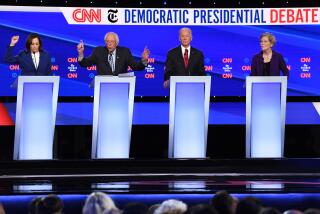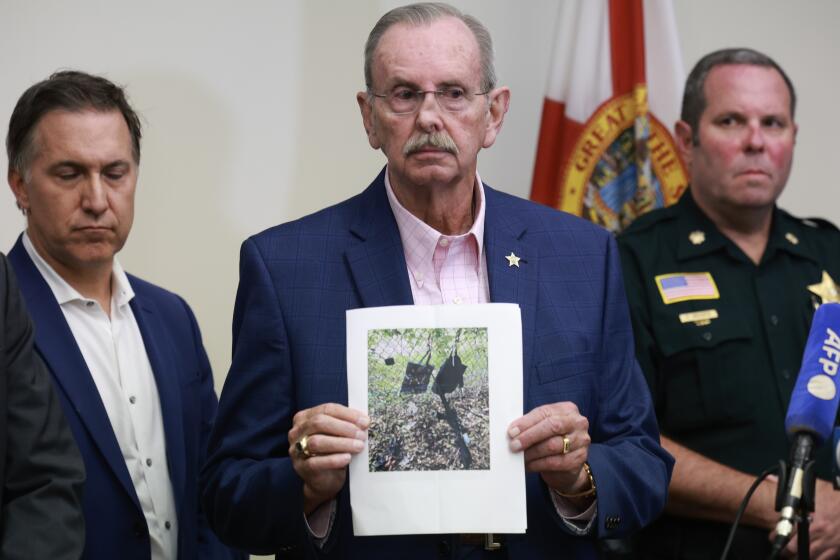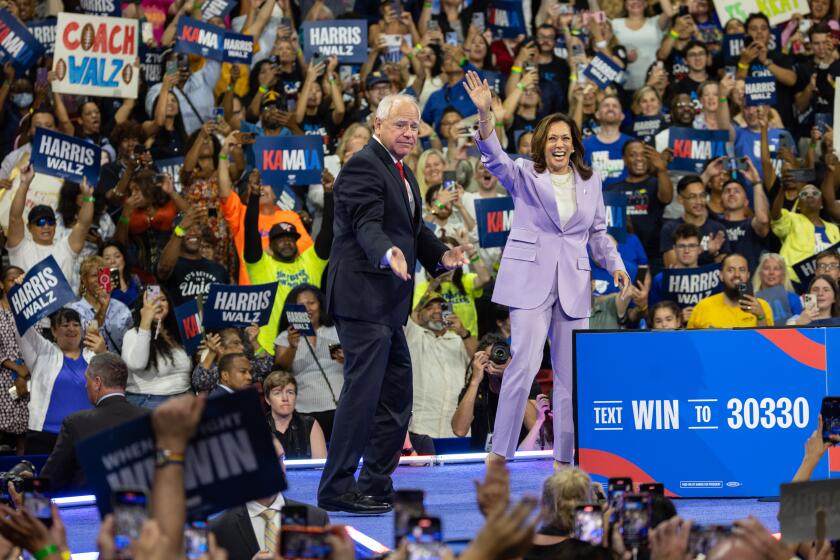EPA Nominee’s Balancing Act Has Its Critics
When President Bush nominated Utah Gov. Mike Leavitt to head the Environmental Protection Agency, he praised Leavitt’s skills as a consensus builder.
He particularly credited Leavitt for corralling 13 governors and 13 Indian tribal leaders, as well as environmental activists and industry leaders, behind one plan to clear the haze obscuring scenic views across the West. On this issue, environmentalists and utility executives alike give Leavitt high marks.
The secret to his success, Leavitt says, is his philosophy of “enlibra,” a word he coined from Latin to mean “move toward balance.”
But Leavitt, 52, has not always achieved the balance that produced the regional clean-air agreement. Environmental groups that have struggled to block oil drilling in Utah’s spectacular red-rock canyon land, to prevent a massive highway through prime wetlands and to clean up vast quantities of toxic wastes tell a different story.
Leavitt, they say, approached these controversies with a clear bias toward development and resource extraction. And he often sought resolutions in closed-door meetings.
As head of the EPA, Leavitt would have broad authority to establish rules regulating what businesses must do to protect the environment. He would also set the tone for how aggressively the government would crack down on companies that violate pollution laws.
People who have dealt with the governor wonder which Leavitt will take over the EPA: the one who advocates development, or the one who seeks broad-based compromises to solve environmental problems.
Industry representatives, environmentalists and longtime advisors to the governor suggest that in the new job, as in the old, some of each is likely to be present.
A review of cases he’s been involved in showed that when a broad group of interests agreed on an environmental goal, Leavitt could be counted on to push a consensus-driven means of achieving it. But when Republican interests clearly lay on one side of a debate, he was more likely to side with industry or other conservative constituencies.
One goal shared by a broad spectrum of interests was that of cleaning the haze that had intruded on such national parks as Arizona’s Grand Canyon and Utah’s Arches, Zion, Bryce and Canyonlands.
For most of his nearly 11 years as governor, Leavitt managed to keep a diverse group of state and tribal officials, representatives from big, polluting companies and environmental activists focused on developing a plan to address the haze problem.
On June 10, 1996, Leavitt stood at the south rim of the Grand Canyon with this unlikely assemblage and announced their hard-won agreement.
But a year later the coalition was on the verge of falling apart. The EPA had developed general clean-air standards, and many of the interested Western parties felt the EPA approach failed to follow their strategy of specific requirements such as developing clean energy sources.
Leavitt did not give up. He went to Washington to testify against the EPA plan. Back in the West, he directed the parties to hash out a new proposal that would alter the EPA’s plan to match their vision.
Vickie Patton was engaged in the process from the start, as a lawyer first for the EPA and then for the national group Environmental Defense, participating in countless acrimonious conference calls and screaming sessions in hotel meeting rooms.
“It can be excruciatingly difficult to find common ground with people who hold very different views,” Patton said. “But if you can do it, in the end you’ll have public policy that has more durable political support.”
The EPA accepted the group’s changes. Arizona, New Mexico, Utah, Oregon and Wyoming have already signed up for the program, and the other eight states must decide this year whether to join. The plan requires step-by-step reductions of regional emissions of sulfur dioxide at a time of exploding population growth.
Power plants, the region’s biggest polluters, would be required to cut emissions by 40% by 2018, with milestones along the way. If the milestones were not met, a mandatory program would kick in. Large polluters would be given emission allotments. Companies that cleaned up faster than required could sell their allotments to dirtier plants that could not meet their targets.
The more vociferous environmentalists, who believe the results were not ambitious enough, at least give Leavitt some credit for the effort.
“He provided good leadership,” said Rick Moore, who took his environmental group, Grand Canyon Trust, out of the process early on. “It was right up Gov. Leavitt’s alley,” because the governor was able to to embrace a broad range of interests and drive them toward consensus. “The process was consensus-driven, with lots of committees and wide-ranging stakeholders,” he said.
The trouble with broad consensus, Moore said, is that it can often be achieved only by significantly watered-down results. He complained that the air pollution control effort was too little and too slow.
The governor’s record on other issues suggests that he uses a collaborative approach selectively to solve environmental problems.
Larry Young, the executive director of the Southern Utah Wilderness Alliance, said the governor has never been willing to use enlibra principles to resolve the perennial dispute over Utah wilderness.
“He invites people to the table who he knows are going to agree with the decisions he’s going to reach and calls everyone else an extremist,” Young said.
Young has been struggling with Leavitt for the better part of a decade over how much of the state’s scenic red-rock canyon country should be wilderness, a designation that would ban motor vehicles, energy extraction and development.
For two years, Young’s group had been trying to get a meeting with Leavitt to talk about the state’s lawsuit contesting protections for 2.6 million acres of federal land in southern Utah. The land had been proposed as wilderness during the Clinton administration, and land managers had been prohibiting most oil development and off-road vehicle access.
Young finally got the meeting with Leavitt in April. But by then Leavitt and Interior Secretary Gale A. Norton had struck a deal behind closed doors.
The deal removed wilderness protections from those 2.6 million acres and forbade the Bureau of Land Management from granting wilderness protections to areas that lacked congressional wilderness designation.
“It’s an example where he didn’t even let us in the door,” said Young. “We asked repeatedly. We sued to get access to records. It was antithetical to the enlibra principles that the governor is touting right now.”
Leavitt declined to be interviewed pending his Senate confirmation hearing, but his supporters said the governor was under no obligation to talk to wilderness advocates before striking the deal with Norton.
“When you settle lawsuits, you don’t hold public meetings,” said LaVarr Webb, a former policy director for the governor.
The oil industry was also kept out of the negotiations. But Lee Peacock, president of the Utah Petroleum Assn., said he believed the governor was reflecting his industry’s interests when he struck the deal.
Through the years, Peacock said, Leavitt has been a “pretty good advocate” of the industry’s access to federal lands.
“He’s had a fairly open-door policy,” Peacock added. “He has done an extremely balanced job of trying to handle the tough issues regarding Utah’s public lands.”
Conservation groups said their rare meetings with the governor had never been fruitful.
During the summer of 1999, Young and representatives of the Sierra Club and the Wilderness Society were invited to meet with the governor at the state’s Washington office. The governor and Bruce Babbitt, President Clinton’s Interior secretary, had agreed to ask Congress to protect 1.1 million acres in Utah’s west desert as wilderness.
The environmentalists came to the meeting ready to negotiate, Young said. But Leavitt told them the plan was not negotiable. He just wanted them to support it.
“There was no collaborative participation,” Young said.
Brad Barber, a longtime Leavitt advisor on land-use issues, was also in the meeting. “The governor said, ‘I’ve gone as far as I can go,’ ” Barber recalled.
The Interior Department was supposed to have been consulting with environmental groups, Barber said. When the governor met with the groups, he had already pushed the local politicians and industries further than they were willing to go.
“That was a lot of wilderness for the governor to propose in a Republican state,” Barber added. “A lot of people thought he had gone off his rocker.”
The environmentalists and then Congress rejected the plan.
Barber conceded that wilderness disputes are one area where the governor’s enlibra philosophy has not achieved collaborative solutions.
“It doesn’t mean he doesn’t believe in it,” Barber added. “It doesn’t mean he didn’t try.”
The challenge for Leavitt, Webb said, is that Utah is a conservative state in which environmental views represent an extreme. But enlibra involves seeking the center and giving a voice to the moderate middle.
“What [Leavitt] would say about consensus-building is that you have to bring people to the middle and both sides have to be willing to compromise and when they won’t you have to stick to the middle,” Webb said.
Finding that center is more art than science, Webb said. Facing elections and governing for 11 years have taught Leavitt how to find the center in Utah, his advisors said. But for the country as a whole, they agreed, the center is elsewhere.
“He will have to deal with that,” Barber said. “I think he has the ability.”
An early challenge will be to draft regulations determining which wetlands and intrastate waterways get the protection of the Clean Water Act. Public-interest groups that were closed out of an effort to design a highway that would cut through wetlands east of the Great Salt Lake have voiced worry that Leavitt will not be protective enough.
Failing to listen to groups that wanted more public transit was costly for a highway project of the governor’s . The groups recently won a lawsuit over the issue, and the Legacy Parkway, which would stretch from Salt Lake City north to Farmington, has been put on hold.
Leavitt’s advisors said he learned from that. He has launched a major highway project in the Mountain View Corridor in Salt Lake County. This time, he set up a collaborative process from the beginning.
*
(BEGIN TEXT OF INFOBOX)
Mixed record
Here are some of the major environmental issues in Utah in recent years, and Gov. Mike Leavitt’s response:
* Regional haze over Grand Canyon and other national scenic treasures on the Colorado Plateau.
Consensus process: Yes. Led by Leavitt and the Western Regional Air Partnership, states, Indian tribes, environmental groups and industry representatives hammer out a plan.
Result: States adopt a declining cap for sulfur dioxide emissions. The Environmental Protection Agency approves it.
* Legacy Parkway project planned through wetlands along the Great Salt Lake.
Consensus process: No. Environmental and so-called smart-growth groups excluded from the planning process.
Result: U.S. 10th Circuit Court of Appeals blocks the project because alternatives such as mass transit that might reduce traffic congestion with less harm to the wetlands were not considered.
* 2.6 million acres receive temporary protection from oil drilling and off-road vehicle access after they were proposed for wilderness designations during the Clinton administration. A state lawsuit challenges those designations.
Consensus process: No. Interior Secretary Gale A. Norton and Leavitt settle the lawsuit.
Result: Areas are no longer given temporary protection, and Bureau of Land Management loses the right to propose areas for wilderness protection.
* Western refiners up in arms over new requirements for low-sulfur fuel as part of tougher pollution standards for motor vehicles.
Consensus process: Yes. The Western Regional Air Partnership brings together oil refiners, environmental groups and state officials.
Result: They agree to implement the new fuel emission standards but give small, independent refiners an extra year to clean up.
More to Read
Get the L.A. Times Politics newsletter
Deeply reported insights into legislation, politics and policy from Sacramento, Washington and beyond. In your inbox three times per week.
You may occasionally receive promotional content from the Los Angeles Times.










